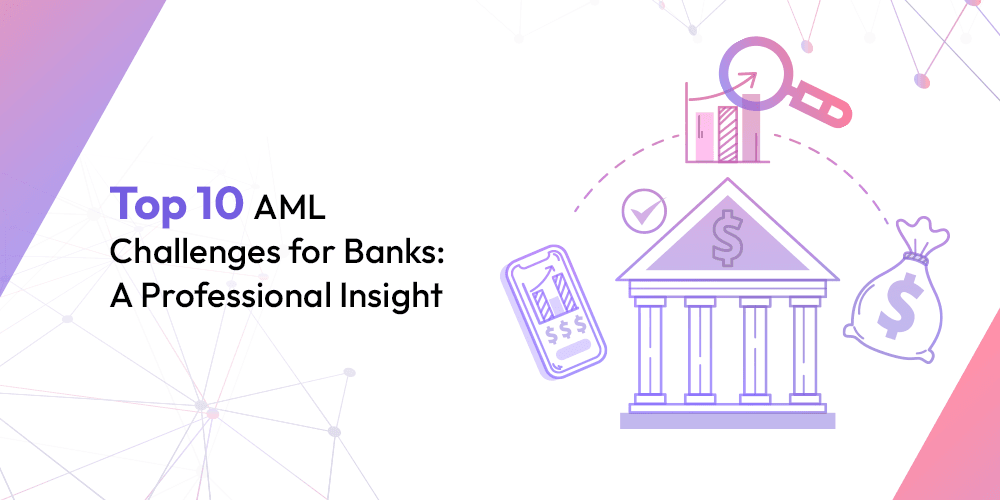
Top 10 AML Challenges for Banks: A Professional Insight
RaptorX.ai
Thursday, September 18, 2025
The financial crime landscape is shifting rapidly. Fraud rings, synthetic identities, and high-velocity laundering methods are now everyday realities for banks. The stakes are high: compliance failures invite regulatory penalties, while weak controls risk financial and reputational damage. To keep up, banks must adopt sharper detection approaches that move beyond surface anomalies and uncover deeper behavioral intent.
Below are ten of the most pressing AML challenges banks face today, along with approaches that address them through advanced pattern, behavior, and intent analysis supported by graph and network intelligence.
1. Detecting Emerging Fraud Typologies
Challenge: New fraud typologies, such as coordinated mule rings or novel synthetic identity schemes, often appear without precedent. Detecting them early is crucial.
What helps:
- Pattern analysis across transactions, accounts, and identities to uncover unusual flows.
- Graph and network models that expose hidden links across entities.
- Real-time scoring across fragmented payment rails so fraud attempts are flagged at first contact.
2. Reducing False Positives
Challenge: Excessive false positives overwhelm compliance teams and dilute investigative focus.
What helps:
- Behavior analysis that filters out normal activity while spotlighting anomalies.
- Risk scoring systems have proven to reduce false positives by up to 40–50%.
- Clear explanations for investigators, why a transaction was flagged, with supporting evidence.
3. Synthetic Identity & Onboarding Fraud
Challenge: Fraudsters increasingly create synthetic profiles stitched from fragments of real and fabricated data. These identities may pass standard verification but pose hidden risks.
What helps:
- Entity resolution that ties together device IDs, IP addresses, and identity attributes.
- Intent analysis at onboarding, detecting when an applicant’s actions diverge from genuine customer behavior.
- Continuous monitoring to catch synthetic accounts that evolve into active laundering nodes.
4. Mule Rings & Laundering Networks
Challenge: Money laundering often occurs through webs of coordinated accounts. Individually, each transaction may look legitimate; collectively, they form a laundering pattern.
What helps:
- Graph and network analysis to trace relationships across accounts and transactions.
- GNN-based scoring that evaluates how suspicious behaviors propagate across connected nodes.
- Detecting cross-channel movement across ACH, wire, and instant payment rails.
5. Account Takeover & Credential Abuse
Challenge: Compromised accounts, via phishing or stolen credentials, allow fraudsters to operate under the guise of legitimate customers.
What helps:
- Behavior analysis of logins: device patterns, IP velocity, concurrent sessions.
- Intent analysis of transaction activity: Are funds being moved with unusual urgency or counterparties?
- Adaptive scoring that flags abnormal behavior in real time.
6. High-Velocity Payment Channels
Challenge: Faster payment rails leave narrow windows to intercept illicit transfers.
What helps:
- Pattern analysis tuned for instant channels like Zelle, ACH, FedWire, or regional fast-payment systems.
- Graph intelligence to identify bursts of connected activity across multiple accounts.
- Sub-second scoring engines that flag risks before settlement.
7. Meeting Regulatory Expectations
Challenge: Regulators demand not only robust monitoring but also clear justification for every decision.
What helps:
- Pre-aligned rule frameworks tuned to mandates like FinCEN or OCC.
- Evidence snapshots are automatically attached to flagged cases for audits.
- Transparency in decision-making, so compliance teams can demonstrate explainability to regulators.
8. Scaling Across Complex Environments
Challenge: Large institutions manage multiple product lines, payment rails, and geographies. Ensuring consistent AML coverage at this scale is difficult.
What helps:
- Agentic AI that adapts dynamically to different transaction environments.
- Network-based detection that scales horizontally as transaction volumes grow.
- Centralized monitoring that unifies disparate data without disrupting business operations.
9. Cross-Channel Anomaly Detection
Challenge: Fraud often reveals itself only when signals across channels are connected—logins, transfers, devices, counterparties.
What helps:
- Cross-channel pattern analysis linking login behavior, transaction flows, and device activity.
- Graph and GNN models that unify these signals into a holistic risk view.
- Ability to escalate not just isolated events but clusters of related anomalies.
10. Protecting Vulnerable Customers
Challenge: Scams exploiting elderly customers or emotional triggers (gift card fraud, impostor schemes) cause both financial and reputational harm.
What helps:
- Behavior analysis of spending habits to detect abrupt deviations.
- Intent analysis to recognize when urgency, repetition, or counterparties suggest manipulation.
- Proactive safeguards, such as second-level verification for high-risk customer segments.
Conclusion
Banks today cannot afford one-dimensional AML defenses. Criminals adapt quickly, exploiting speed, complexity, and customer vulnerabilities. The way forward lies in agentic AI systems that combine pattern, behavior, and intent analysis with graph and network intelligence, capable of exposing hidden laundering webs while minimizing noise.
By addressing these ten challenges head-on, financial institutions can build AML frameworks that not only satisfy regulators but also truly protect their customers and reputations.

